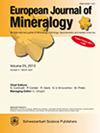Li–Na interdiffusion and diffusion-driven lithium isotope fractionation in pegmatitic melts
IF 1.7
3区 地球科学
Q2 MINERALOGY
引用次数: 0
Abstract
Abstract. In this study, we investigate the diffusion of Li and its stable isotopes (6Li and 7Li) in flux-rich (1.8 % Li2O, 2.6 % B2O3, 2.3 % P2O5 and 3 % F) pegmatitic melts in order to contribute to the understanding of Li enrichment in such systems. Two glasses were synthesized with a model pegmatitic composition, one of which is highly enriched in Li (> 1 wt %, PEG2-blue) and the other one essentially Li-free (PEG2-Li-free). Diffusion couple experiments were performed to determine the chemical diffusivity of Li in dry pegmatitic melts. Experiments were conducted using rapid-heat and rapid-quench cold-seal pressure vessels in a temperature range of 650–940 ∘C at 100 MPa with Ar as the pressure medium. We observed rapidly formed diffusion profiles, driven by an interdiffusive exchange of the monovalent alkalis Li and Na, while the other elements are immobile on the timescale of experiments (1–30 min). From these experiments, activation energies for Li–Na interdiffusion were determined as 99 ± 7 kJ mol−1 with a pre-exponential factor of log D0 = −5.05 ± 0.33 (D0 in m2 s−1). Li and Na partitioning between the stronger depolymerized PEG2-blue and the less depolymerized PEG2-Li-free leads to a concentration jump at the interface; i.e. Na is enriched in the more depolymerized PEG2-blue. Li–Na interdiffusion coefficients in the studied melt composition are in a similar range as Li and Na tracer diffusivities in other dry aluminosilicate melts, confirming little to no effect of aluminosilicate melt composition on Li diffusivity. Thus, added fluxes do not enhance the Li diffusivity in the same way as observed for H2O (Holycross et al., 2018; Spallanzani et al., 2022). Using melt viscosity as a proxy for the polymerization of the melt shows that water has a stronger potential to depolymerize a melt compared to other fluxing elements. Faster diffusion of 6Li compared to 7Li leads to a strong Li isotope fractionation along the diffusion profile, resulting in δ7Li as low as −80 ‰ relative to the diffusion-unaffected regions. This diffusive isotope fractionation can be quantified with an empirical isotope fractionation factor (β) of 0.20 ± 0.04, similar to previously observed β values for Li diffusion in melts. This suggests in accordance with previously published data that a β value of ca. 0.2 seems to be universally applicable to diffusive Li isotope fractionation in aluminosilicate melts.伟晶岩熔体中的锂呐互扩散和扩散驱动的锂同位素分馏
摘要在本研究中,我们研究了锂及其稳定同位素(6Li 和 7Li)在富通量(1.8 % Li2O、2.6 % B2O3、2.3 % P2O5 和 3 % F)伟晶岩熔体中的扩散情况,以帮助理解锂在此类体系中的富集情况。我们合成了两种具有伟晶岩成分模型的玻璃,其中一种玻璃的锂含量很高(> 1 wt %,PEG2-蓝色),另一种玻璃基本上不含锂(PEG2-无锂)。为了确定锂在干伟晶岩熔体中的化学扩散性,我们进行了扩散耦合实验。实验是在温度范围为 650-940 ∘C、压力为 100 MPa、以 Ar 为压力介质的快速加热和快速淬火冷密封压力容器中进行的。我们观察到在一价碱 Li 和 Na 的相互扩散交换驱动下迅速形成的扩散曲线,而其他元素在实验时间尺度上(1-30 分钟)是不移动的。通过这些实验,确定了锂-纳相互扩散的活化能为 99 ± 7 kJ mol-1,预指数为 log D0 = -5.05 ± 0.33(D0 单位为 m2 s-1)。Li 和 Na 在解聚度较高的 PEG2-blue 和解聚度较低的 PEG2-Li-free 之间的分配导致了界面处的浓度跃迁;即 Na 在解聚度较高的 PEG2-blue 中富集。所研究的熔体成分中的锂-纳相互扩散系数与其他干硅酸铝熔体中的锂和纳示踪剂扩散系数范围相似,这证明硅酸铝熔体成分对锂扩散性几乎没有影响。因此,添加的通量不会像在 H2O 中观察到的那样提高锂的扩散率(Holycross 等人,2018 年;Spallanzani 等人,2022 年)。使用熔体粘度作为熔体聚合的替代物表明,与其他助熔剂元素相比,水具有更强的解聚熔体的潜力。与 7Li 相比,6Li 的扩散速度更快,这导致沿扩散剖面出现强烈的 Li 同位素分馏,使 δ7Li 相对于不受扩散影响的区域低至 -80 ‰。这种扩散同位素分馏可以用经验同位素分馏系数(β)0.20 ± 0.04 来量化,与之前观测到的熔体中 Li 扩散的 β 值相似。这与之前公布的数据一致,表明约 0.2 的 β 值似乎普遍适用于铝硅酸盐熔体中的锂同位素扩散分馏。
本文章由计算机程序翻译,如有差异,请以英文原文为准。
求助全文
约1分钟内获得全文
求助全文
来源期刊
CiteScore
2.80
自引率
9.50%
发文量
40
审稿时长
6-12 weeks
期刊介绍:
EJM was founded to reach a large audience on an international scale and also for achieving closer cooperation of European countries in the publication of scientific results. The founding societies have set themselves the task of publishing a journal of the highest standard open to all scientists performing mineralogical research in the widest sense of the term, all over the world. Contributions will therefore be published primarily in English.
EJM publishes original papers, review articles and letters dealing with the mineralogical sciences s.l., primarily mineralogy, petrology, geochemistry, crystallography and ore deposits, but also biomineralogy, environmental, applied and technical mineralogy. Nevertheless, papers in any related field, including cultural heritage, will be considered.

 求助内容:
求助内容: 应助结果提醒方式:
应助结果提醒方式:


